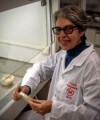Actualidad
The methyl ester of protocatechuic acid prevents gray mold in strawberries during postharvest
The methyl ester of protocatechuic acid inhibits the development of Botrytis cinerea in postharvest strawberry fruits through direct antifungal activity and enhancement of host resistance responses
Botrytis cinerea (Ascomycota) is the fungus most commonly causing gray mold on fresh fruits and vegetables at harvest due to its exceptionally wide host range and adaptability, causing significant economic losses in strawberries, apples, tomatoes, and peppers.
Strawberries are typical hosts of B. cinerea and suffer significant commercial damage. More than 25% of the fruits are lost after harvest due to decay caused by this phytopathogen.
Currently, certain synthetic chemical fungicides such as mefentrifluconazole, tebuconazole, and iprodione have been applied against gray mold. However, the widespread use of these substances has gradually increased resistance and had a negative impact on food safety and environmental pollution. Therefore, it is essential to develop environmentally friendly agents instead of traditional fungicides to control postharvest gray mold disease.
Control through Plant-Origin Compounds
Currently, the use of biologically active compounds of plant origin is considered a viable method to control gray mold after harvest. Phenolic compounds, plant essential oils, and benzyl isothiocyanate have been used as natural fungicides against B. cinerea infection. Among them, the detection and functional analysis of phenolic compounds and their derivatives have attracted great attention. Previous studies have shown that phenolic compounds, including p-coumaric acid, ferulic acid, caffeic acid, epicatechin, and magnolol, effectively prevent B. cinerea in vivo and in vitro.
Methyl ester of protocatechuic acid, known as PCAME and also as methyl 3,4-dihydroxybenzoate, is a phenolic compound that can be isolated from plants such as Phymatopteris hastata (Polypodiaceae family), Bauhinia variegata, and Entada rheedii (both Fabaceae family).
PCAME exhibits multiple biological effects such as antioxidant, neuroprotective, antidiabetic, anti-aging, anti-inflammatory, and parasiticidal against Leishmania. Previous studies have demonstrated antifungal activity against Fusarium culmorum.
Antifungal Activity of PCAME
Recent research determined the efficacy of PCAME to control B. cinerea in vitro and in vivo. It was verified to inhibit mycelial growth and spore germination, and decrease the susceptibility of strawberries to invasion.
It was also demonstrated to effectively alter the transcriptional profile of B. cinerea by inducing the transcription of genes related to oxidative stress and lipid peroxidation of the cell membrane, causing alteration of this structure leading to fungal cell death.
These results were verified through increased extracellular conductivity, leakage of cytoplasmic constituents, including sugars and nucleotides, and alteration of cellular structures through staining techniques.
On the other hand, treatment with PCAME activated the expression of genes involved in antioxidant metabolism and defense-related proteins in strawberries infected with B. cinerea.
These data suggest that PCAME, a natural agent, inhibits postharvest gray mold disease in strawberries through direct antifungal activity and enhancement of host resistance responses.
Graphic summary according to Yuan, S. et al,2024
* Methyl ester of protocatechuic acid, protocatechuic acid methyl ester, or methyl 3,4-dihydroxybenzoate
Sources
Yuan, S.; Wang, B.; Wang, M.; Minmin Sun a, Wang, X.; Li, X.; Yang, N.; Xu,X.; Zheng, S.; Wang, Q. (2024). Antifungal mechanism of protocatechuic acid methyl ester against Botrytis cinerea in postharvest strawberry fruit Postharvest Biology and Technology, 211: 112787.
https://vi.m.wikipedia.org/wiki/Phymatopteris_hastata Accessed on 27/05/2024.
https://pt.wikipedia.org/wiki/Bauhinia Accessed on 27/05/2024.
https://pt.wikipedia.org/wiki/Entada Accessed on 27/05/2024.
Images
https://pt.wikipedia.org/wiki/Protocatecuato_de_metila Accessed on 27/05/2024.
https://www.facebook.com/LaboratorioFitopatologiaUcr/videos/botrytis-en-fresa/410209762956827/ Accessed on 27/05/2024.













